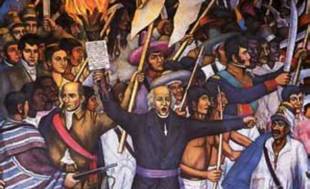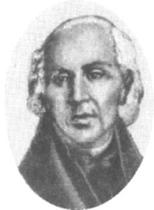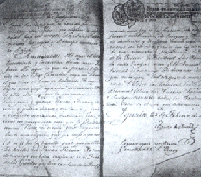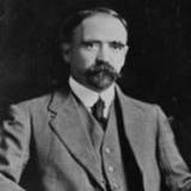Basic Gist
5.3.2c by Mishka Wildemaan and Evan Dafoe
The Mexican Revolution
The Mexican war for independence officially
began on September 16th, 1810, albeit tension between Mexican and
the Spanish crown can be traced back even earlier. The first recorded act of
rebellion against Spain in Mexico can be traced back to Martin Cortez, son of
Hernan Cortez, leading a revolt against the colonial government to eliminate
the privileges of the conquistadors. Another act of rebellion was in 1799 with
the Conspiracy of the Machetes where the conspirators intended to claim the
independence of Mexico, declare war on Spain, and kill or expel all Peninsulas. The band only had two pistols
and roughly fifty cutlasses and machetes, where the name originated. One of the
fellow conspirators turned the band into the authorities and they were all
arrested in secret in order not to rouse the populace.
Eleven years following the Conspiracy of the Machetes , Father Miguel Hidalgo declared the independence of Mexico and war on Spain in what became known as the Grito de Dolores ("Cry of Dolores") also known as El Grito de la Independencia ("Cry of Independence"). Hidalgo and his followers began to march on the Capital of Mexico City and found victories along the way in Guanajuato and at the battle of Monte de las Cruces. The rebel force lost to the much larger and better armed Spanish army at Mexico City and forced a retreat. In January 1811, the rebel forces encountered the Spanish army at the Battle of the Bridge of Calderon where they were defeated once again. This had the rebel forces fleeing to the Mexican-American border in hopes of escape but the Spanish military intercepted them and Hidalgo and his followers were tried and executed for treason. Following Hidalgos execution, leadership of the rebellion fell to Jose Maria Morelos whose leadership had led to the occupation of the cities of Oaxaca and Acapulco. Morelos was captured by Spanish authorities in 1815 and was executed for treason like his predecessor, Hidalgo. In 1813, the Congress of Chipancingo and on November 6th signed the first official document known as the Solemn Act of the Declaration of Independence of Northern America, officially freeing Mexico from Spanish rule. From 1815 to 1821, most of the fighting was done in guerilla bands. But in 1820, the rebels were on the defensive and the Spanish Military, under the command of Agustín de Iturbide, was sent to the city of Oaxaca to defeat the rebel forces led by Vicente Guerrero. After hearing word of a coup in Spain against Ferdinand VII and the signing of the Spanish Constitution of 1812, Iturbide saw a chance to take control of Mexico and convened an arrangement with Guerrero to discuss a renewed independence struggle. After signing a treaty with representatives of the Spanish crown, Iturbide was elected ruler of Mexico by the Mexican Congress and the country was finally free from the rule of Spain. The Mexican Revolution of 1910 was led against the Mexican leader, Porfirio Díaz, was by Francisco I. Madero. It lasted around 10 years, ending in 1920. People began fighting because they were tired of the Mexican political system, which was corrupt, and they were also uncontent with the system of foreign investments that were running the country. Citizens from all social levels fought, poor, middle, and upper class. Madero himself gained support to fight because he believed that Diaz had a monopoly on the government, which can be demonstrated by the fact that Diaz had Madero thrown in jail during elections because he did not want to risk losing. After being released from jail, he called for a rebellion, claiming that the elections were false and the government was corrupt. Armed rebellions were already taking place all around Mexico, because of the political turmoil that had taken place. Emiliano Zapata, a peasant leader in the south, took up arms, determined to gain a land reform. Muleteer Pascual Orozco and bandit chieftain Pancho Villa also took up arms, and together all three of them rallied armies of thousands. In the south, Zapata attacked the ranches, gaining back land that had been illegally stolen from the peasants by the government. In the north, Orozco and Villa's armies attacked federal garrisons and collected weapons, all the while gaining more troops and recruits. Together, they did very well against the government, and soon Madero joined them, and they marched against the capital. Diaz soon saw that he could not win, and went into exile. Madero entered the city, and claimed himself president pro-temp until a new election could be held. Madero's presidency was short lived, however, because the remaining Diaz followers did not approve of his leadership. He also did not uphold promises he made to his accomplices, ans Orozco, sensing this, took up arms along with Zapata, since Madero had no interest in land reform. They declared a revolution against him. Villa was Madero's only remaining ally. Madero realized this too late though, and was killed by a general still loyal to Diaz, Victoriano Huerta. Huerta soon became president, backed by Orozco. Villa and Zapata, however, hated Huerta, and plotted revenge. Former governor Venustiano Carranza and farmer Alvaro Obregón also joined them. They fought against Huerta and Orozco, steadily pushing them back. Soon they had no choice but to go into exile and surrender. Now they were the most powerful men in Mexico. Unfortunately, they were allied only in their hate of Huerta, and soon began to fight amongst themselves. Carranza sided with Obregón, but did not fully trust him. Carranza soon won the fight, and was elected president. Villa and Zapata had withdrawn, and Obregón waited, knowing that he would be elected after Carranza. But Carranza wanted another as his sucessor, and because of this, Obregón fought him and soon came to power, being easily and legally elected. |
|




